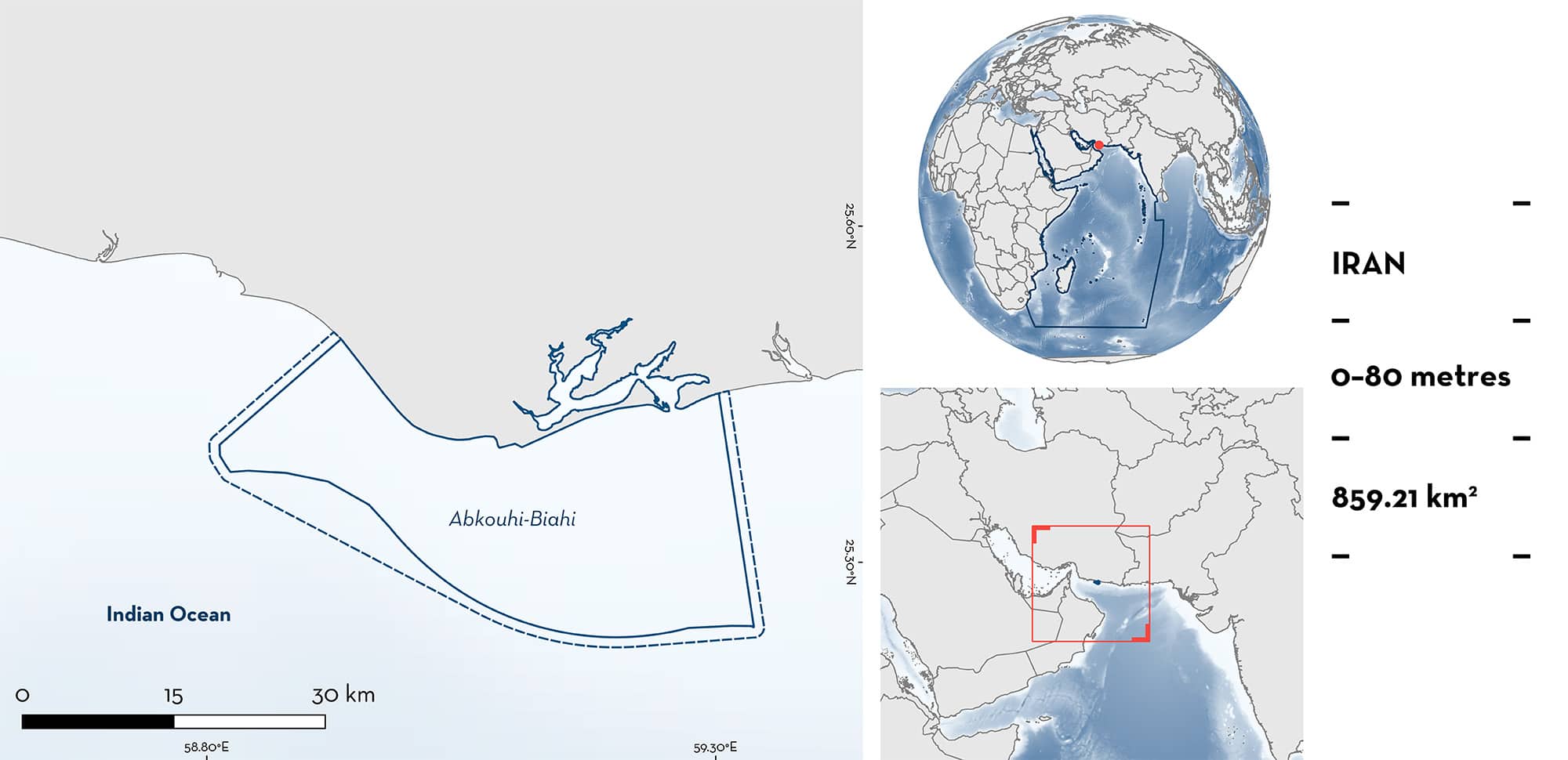ISRA FACTSHEETS
ISRA FACTSHEETS
WESTERN INDIAN OCEAN REGION
Abkouhi-Biahi
Summary
Abkouhi-Biahi is part of the Iranian Exclusive Economic Zone in the eastern Gulf of Oman. It mainly comprises the continental shelf waters of east Hormozgan Province and a marginal amount of the western boundary of Sistan-and-Baluchestan Province. The area is characterised by an estuary and rocky and sandy substates. Within this area there are: threatened species (e.g., Sharptooth Lemon Shark Negaprion acutidens); range restricted species (Sharpnose Guitarfish Glaucostegus granulatus); reproductive areas (Sharptooth Lemon Shark); and undefined aggregations (Sharpnose Guitarfish).
Download factsheet
Abkouhi-Biahi
DESCRIPTION OF HABITAT
Abkouhi-Biahi is part of the Iranian Exclusive Economic Zone in the eastern Gulf of Oman. The area mainly comprises the continental shelf waters of east Hormozgan Province and a marginal amount of the western boundary of Sistan-and-Baluchestan Province. The Rapch Estuary at the east of the area is the only Iranian estuary along the Iranian coastline of the Gulf of Oman without mangroves (Naderloo et al. 2023).
Nutrient-rich Arabian Sea upwelling currents that mainly influence the Omani coast at the southern Gulf of Oman also affect Iranian coastal habitats, including this area, leading to planktonic blooms (IFSRI 2009; Ershadifar et al. 2022).
This Important Shark and Ray Area is benthopelagic and is delineated from inshore and surface waters (0 m) to 80 m based on the bathymetry of the area.
CRITERION A
VULNERABILITY
Two Qualifying Species considered threatened with extinction according to the IUCN Red List of Threatened SpeciesTM regularly occur in the area. These are the Critically Endangered Sharpnose Guitarfish (Kyne et al. 2022) and the Endangered Sharptooth Lemon Shark (Simpfendorfer et al. 2021).
CRITERION B
RANGE RESTRICTED
This area holds the regular presence of Sharpnose Guitarfish as a resident range-restricted species. Sharpnose Guitarfish represented 6% (n = 54) of rays caught by demersal gillnets during the monitoring of landings in 2022–2023 (M Rezaie-Atagholipour unpubl. data 2022–2023). Also during that period, a mean of >100 individuals per day were observed in catches during artisanal surveys from fisheries operating in the area, while in other parts of Iran, much smaller numbers of individuals were observed (M Rezaie-Atagholipour unpubl. data 2022–2023). During interviews, 45 of 85 fishers working at the landing site confirmed the landed species were captured in the area, with fishing grounds reaching 18.5 km seaward. This species occurs in the Arabian Sea Large Marine Ecosystem (LME) and the Bay of Bengal LME.
CRITERION C
SUB-CRITERION C1 – REPRODUCTIVE AREAS
Abkouhi-Biahi is an important reproductive area for one shark species. During shark and ray surveys once a year in 2022 and 2023, sharks were examined at the landing sites of fishers operating in the area, and 85 fishers were interviewed to collect ecological information (M Rezaie-Atagholipour unpubl. data 2022–2023).
During interview-based surveys in 2023, a fisher shared a photo of his boat full of small Sharptooth Lemon Sharks (> 20 specimens) from Rapch (Karati) Estuary in the eastern part of the area, which were estimated to have a size of < 50 cm total length (TL). Four other 60–70 cm TL juveniles were also observed landed together in a nearby landing site (Bandar-e-Darak) in 2019 (HR Bargahi pers. obs 2023). Subsequent interviews with four other fishers in 2023 confirmed that similar catches regularly occur in estuarine habitat of the area from April to July. Size-at-birth of this species is 45–80 cm TL (Ebert et al. 2021) and therefore the observations above were assumed to represent neonates and/or young-of-the-year.
CRITERION C
SUB-CRITERION C5 – UNDEFINED AGGREGATIONS
Abkouhi-Biahi is an important area for undefined aggregations for one species of ray.
During landing site surveys, the number of landed Sharpnose Guitarfish in one of the landing sites inside the area (Biâhi) was considerable (i.e., a mean of >100/day recorded during three days of surveys in 2022 and 2023, with a range of 5–10 individuals per boat; M Rezaie-Atagholipour unpubl. data 2022–2023), while in other landings sites in the area (Googsar, Abkouhi, and Bahal), no more than seven individuals were observed per day (range = 1–7). A sample of 31 individuals was randomly examined with a sex ratio of 7 female: 1 male. All examined males were mature (based on their clasper stage), and all examined females were >117 cm TL (range, 117–178 cm TL). Therefore, based on the size-at-maturity of this species (i.e., ~98 cm TL for males; Last et al. 2016), the animals were assumed to be mature. Further information is needed to understand the function of these aggregations.
Download factsheet
SUBMIT A REQUEST
ISRA SPATIAL LAYER REQUEST
To make a request to download the ISRA Layer in either a GIS compatible Shapefile (.shp) or Google Earth compatible Keyhole Markup Language Zipped file (.kmz) please complete the following form. We will review your request and send the download details to you. We will endeavor to send you the requested files as soon as we can. However, please note that this is not an automated process, and before requests are responded to, they undergo internal review and authorization. As such, requests normally take 5–10 working days to process.
Should you have questions about the data or process, please do not hesitate to contact us.


